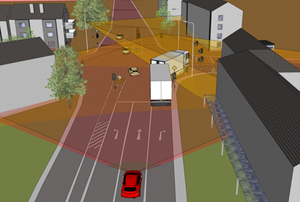INTERSAFE 2 has developed ‘intersection safety’, a new application set to reduce accidents at intersections.
An innovative vehicle and infrastructure technology has the potential for a substantial reduction of accidents at intersections. Three automotive manufacturers, together with eight partners from industry and research, have collaborated to work on the necessary assistance and safety applications within the European research initiative ‘INTERSAFE 2’. The demonstration vehicles and a demonstration intersection were presented at the ‘Final Event’ on 17/18 May, 2011 in Wolfsburg, Germany so they could be experienced first-hand.
 43% of all European traffic accidents that result in injuries take place at intersections. This is why the INTERSAFE 2 partners focused on the topic of safety at road junctions and technically implemented four assistance and safety applications that anticipate typical traffic situations. The assistance and safety applications are intended to assist drivers in critical situations. The aim is to considerably reduce the effects of an accident or, ideally, completely prevent it. The applications are based on sensors installed at the intersections and in vehicles and that are linked in a cooperative system. Information is exchanged between the intersection and the vehicle via a special radio connection and then evaluated in the vehicle so that the necessary measures can be undertaken if necessary. All the applications initially warn the driver with a visual and acoustic signal and, if the warning is ignored, the driver’s attention is gained by means of a brief brake jerk.
43% of all European traffic accidents that result in injuries take place at intersections. This is why the INTERSAFE 2 partners focused on the topic of safety at road junctions and technically implemented four assistance and safety applications that anticipate typical traffic situations. The assistance and safety applications are intended to assist drivers in critical situations. The aim is to considerably reduce the effects of an accident or, ideally, completely prevent it. The applications are based on sensors installed at the intersections and in vehicles and that are linked in a cooperative system. Information is exchanged between the intersection and the vehicle via a special radio connection and then evaluated in the vehicle so that the necessary measures can be undertaken if necessary. All the applications initially warn the driver with a visual and acoustic signal and, if the warning is ignored, the driver’s attention is gained by means of a brief brake jerk.
The following applications were presented at the Final Event:
Right-turn Assistant
When turning right at an intersection, the Right-turn Assistant monitors the turning path and, in order to prevent an accident, triggers a warning when a pedestrian or cyclist approaches.
Left-turn Assistant
The Left-turn Assistant analyses the oncoming traffic and evaluates the turning situation. The system warns the driver if it detects danger. If the vehicle is standing ready in the intersection and waiting for a gap in the oncoming traffic the vehicle only releases the brakes when a suitable gap appears, to prevent any collision with oncoming traffic.
Intersection Assistant
This support function monitors the transverse and crossing traffic, triggering a warning in critical situations. This is of particular assistance to the driver when a direct view of the transverse traffic is blocked by other vehicles or buildings. This is enabled by the use of laser scanners at the intersection that detect the positions of the other road users and transfer this information to the vehicle via wireless communication.
Red light violation/ignoring right of way
If a driver appears to be about to ignore a red light or a stop sign he initially receives a warning. If the driver fails to react, a brief brake jerk is activated to increase the driver’s attention level and prevent an accident or dangerous situation.
The INTERSAFE 2 research initiative supported by the European Commission DG-ICT stands for ‘intersection safety’ and has been funded with a total budget of euro 6.5 million. The European Commission has contributed euro 3.5 million while industry has provided euro 3 million. Eleven partners from industry and science, located in six European countries, are participating. The aim of this research cooperation, planned to last three years, is to increase the safety of traffic at intersections.
The INTERSAFE 2 partners are: the BMW Group, IKA, Inria, NEC, Swarco, TRW, Conekt, VTT, SICK (project coordination), the Cluj-Napoca Technical University, Volvo AB, VIT and Volkswagen AG.
Further information is available at: http://www.intersafe-2.eu.

INTERSAFE 2 has developed ‘intersection safety’, one of four applications it hopes will prevent, or at least reduce, the effects of an accident. The application monitors the transverse and crossing traffic lights at intersections and triggers a warning in critical situations.